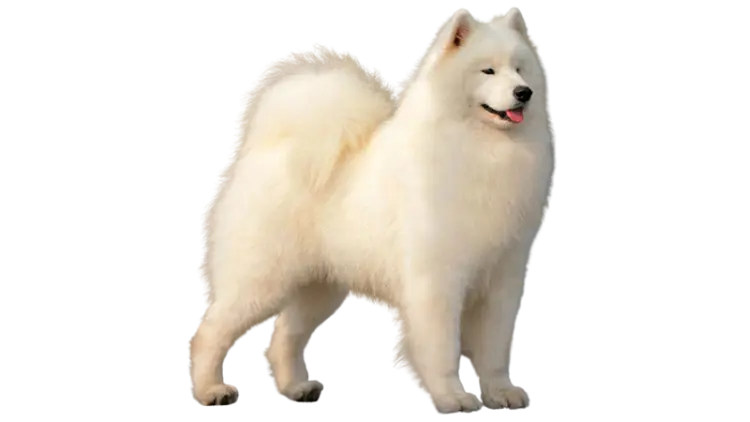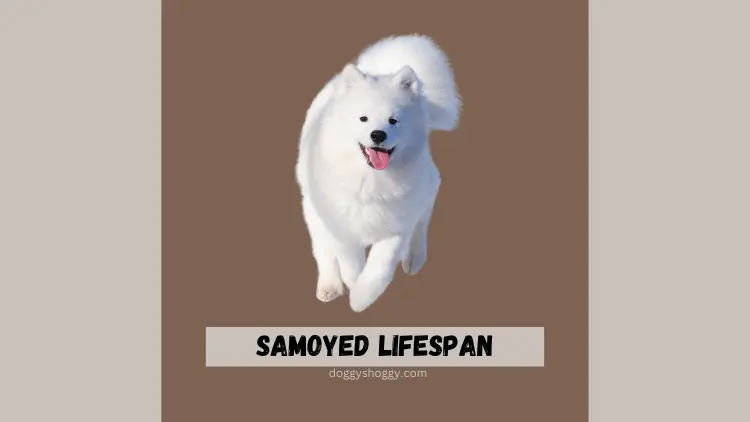Samoyed Dog Breed Overview

Samoyed Dog Breed
Samoyed dogs are fluffy and friendly pets. They have thick white fur that keeps them warm in cold weather. These dogs love to be around people and make great companions for families. They’re playful and like to have fun, but they also enjoy relaxing with their loved ones. Samoyeds are known for their happy smiles, which can brighten anyone’s day. Overall, they’re wonderful furry friends to have around.
Weight
45-65 pounds
Height
21-23.5 inches
Lifespan
12 to 14 years
Breed
Samoyed
Table of Contents
Origins and History of the Samoyed

It is a big dog with a white, fluffy coat and a happy face. People sometimes call them Smiling Sammies because they look like they’re always smiling. These dogs came from Siberia, a cold place in Russia. Long ago, the Samoyede people bred them to help with tasks like herding reindeer, pulling sleds, and keeping them warm in the cold weather.
Ancient Beginnings
This Dog has been around for a long, long time, for thousands of years. The Samoyede people, who moved from place to place, really loved these dogs. They needed them to help them live in the cold Arctic place where they stayed. These Dogs weren’t just helpers; they were like family members too. They kept the people company and protected them from danger.
Arctic Expeditions
In the late 1800s and early 1900s, adventurers like Ernest Shackleton and Roald Amundsen took these dogs with them on their trips to the Arctic. These dogs were super important during these journeys. They pulled sleds, watched over the camps, and kept their human friends warm. People all over the world were amazed by how brave, loyal, and strong these dogs were.
Spread Across the Globe
When explorers came back from their trips to the Arctic, they brought these dogs with them to other places in the world. People really liked these dogs because they were friendly and looked so pretty. They became really popular as pets and even in dog shows. Nowadays, you can find these dogs in homes all around the world, making their families happy with their love and joy.
Physical Characteristics and Appearance

When you think about a Samoyed dog, what do you imagine? Maybe it’s their big, fluffy white fur or the way they always seem to be smiling. The way they look is really special and catches your eye. Let’s explore what makes them so beautiful and different from other dogs.
Fluffy White Coat
these dogs have a really special coat that helps them stay warm in cold weather. It’s made of two layers: the outside layer is long and straight, while the inside layer is soft and thick. This coat keeps them warm and also helps keep them clean, even if they play in the mud.
Signature Smile
These Dogs are known for their special Sammy smile. Their mouths naturally turn up at the corners, making them look friendly and happy. That’s why people call them Smiling Sammies. When you see their bright eyes and big smiles, you can’t help but feel happy too!
Sturdy Build
Under all that fluff, these dogs have strong muscles and a solid build. They have a good shape with a strong chest, straight legs, and a back that’s level. Their tails are fluffy and held high over their backs, making them look very grand. When they move, they look graceful and powerful at the same time.
Temperament and Personality Traits
these dogs are famous for their friendly and loyal nature, making them wonderful pets for families. They have a special mix of qualities that make them really great companions. Let’s discover what makes them so lovable and why they’re adored by everyone who meets them.
Affectionate and Friendly
these dogs are famous for how much they love their families. They really enjoy being around people and want to be part of everything the family does. Whether it’s snuggling up together on the couch or playing outside, these dogs are happiest when they’re with their loved ones, giving them lots of love and attention.
Readers Also Like: PUG DOG Breed Overview
Gentle Giants
They are big, and really gentle and patient dogs, especially with children. They really like kids and are like gentle protectors, looking out for them with love and care. Their calm and patient nature makes them great pets for families with kids of any age.
Playful and Energetic
They look fluffy and cuddly, these dogs are actually very energetic and playful dogs. They really enjoy being active outdoors, whether it’s running, hiking, or playing games like fetch. Their endless energy and excitement are infectious, which means they’re great friends for people who like to stay active and have fun.
Care and Grooming Needs

Taking care of a Samoyed involves more than just feeding and housing them. These beautiful dogs have special needs to stay healthy and happy. From looking after their fluffy coat to making sure they get enough exercise, taking care of a Samoyed requires commitment and careful attention. Let’s explore the important things you need to know to keep your Samoyed in top shape.
Coat Care
To keep your Samoyed’s coat looking its best, regular grooming is key. Brushing their fur a few times each week helps keep it clean and free of tangles. This is especially important during shedding season when they lose a lot of hair. When it’s time for a bath, use a gentle dog shampoo to keep their coat healthy and shiny, preserving its natural oils.
Exercise Requirements
These Dogs are lively dogs and need daily exercise to stay happy and healthy. Taking them for long walks, runs, or playing in a fenced yard is important to keep them mentally and physically engaged. Without enough activity, they might get bored and start doing things like chewing on things they shouldn’t.
Training and Socialization
Starting training and making friends early is really important for Samoyeds to be good pets. Using positive methods, like giving treats and praise, works best because they like being rewarded. Introducing them to lots of different people, animals, and places when they’re young helps them grow up to be friendly and not scared or mean.
Bottom Line
The Samoyed is a magnificent breed with a rich history and a lovable personality. From their ancient origins as Arctic working dogs to their role as beloved family pets today, Samoyeds have captured the hearts of people worldwide with their charm and affectionate nature.
10 Useful and Unique FAQs With Answer
Are these dogs hypoallergenic?
While no dog breed is completely hypoallergenic, Samoyeds produce fewer allergens than some other breeds, making them suitable for allergy sufferers with proper grooming.
Do Samoyeds shed a lot?
Yes, Samoyeds have a thick double coat that sheds heavily, especially during shedding seasons in the spring and fall. Regular grooming can help manage shedding.
Are these dogs good with children?
Yes, Samoyeds are gentle and patient with children, making them excellent family pets. However, supervision is always recommended, especially with younger children.
Do Samoyeds bark a lot?
Samoyeds are known for their vocal nature and may bark to alert their owners or express excitement. Proper training can help reduce excessive barking.
Are these dogs difficult to train?
While Samoyeds are intelligent dogs, they can be independent and stubborn at times. Consistent training with positive reinforcement is key to success.
Do Samoyeds need a lot of exercise?
Yes, Samoyeds are energetic dogs that require daily exercise to stay healthy and happy. Activities like walking, running, and playtime are essential for their well-being.
Are Samoyeds good guard dogs?
Samoyeds are friendly and sociable dogs that may not excel as guard dogs. However, their alert nature and protective instincts make them excellent watchdogs.
Do Samoyeds have health issues?
While generally healthy, Samoyeds may be prone to certain health issues like hip dysplasia, progressive retinal atrophy, and diabetes. Regular vet check-ups are important for early detection and treatment.
How long do these dogs live?
On average, Samoyeds have a lifespan of 12 to 14 years. Providing proper care, nutrition, and regular exercise can help extend their lifespan.
Are Samoyeds good apartment dogs?
While Samoyeds can adapt to apartment living with enough exercise and mental stimulation, they thrive in homes with access to a fenced yard where they can run and play freely.

